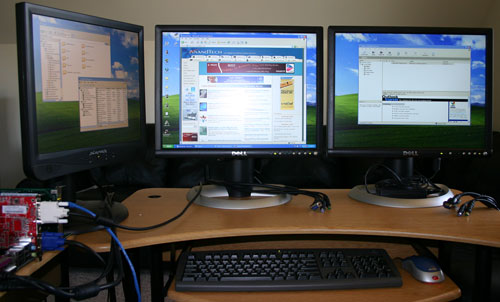
Original Link: https://www.anandtech.com/show/1537
ATI Radeon Xpress 200: Performance, PCI Express & DX9 for Athlon 64
by Wesley Fink on November 8, 2004 6:00 AM EST- Posted in
- CPUs
About 6 months ago, we reported that ATI would be introducing their first chipset for AMD Athlon 64. Between that first report and today's introduction of the ATI RX480 chipset, a lot has happened. In round 2 of the A64 chipset wars, the industry moved from the single-channel memory Socket 754 to the dual-channel Socket 939. VIA morphed their successful K8T800 chipset into the K8T800 PRO by adding 1000 Hyper Transport and a PCI/AGP lock. nVidia performed a more massive transformation of their nForce3 chipset, moving from the pedestrian nForce3-150 to the leading-edge nForce3-250 family in May. Clearly, the stakes for a new player in the Athlon 64 chipset market went up as Athlon 64 chipsets evolved.
Fast forward just five months and round 3 begins. nVidia and VIA both introduce PCI Express graphics into the Athlon 64 equation. However, the pioneer for discrete PCI Express graphics has been ATI, so it should come as no surprise that ATI is choosing round 3 to launch their first chipset for the AMD Athlon 64 - the RX480 discrete graphics chipset and the sister RS480 with integrated graphics.
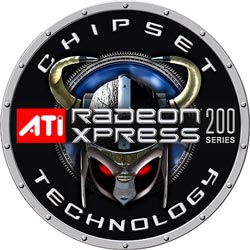
In the larger marketplace, ATI has timed this introduction perfectly. Athlon 64 is now the undisputed performance king among processors, and the retail market share has been growing rapidly for the Athlon 64 processors. Looking ahead, the next year is likely to continue to be a great climate for Athlon 64 processors as Intel regroups for their next CPU introductions. AMD is in the process of successfully moving production to 90nm, which will likely allow even further extension of their performance lead. AMD also seems to have avoided the power and heat problems that have plagued Intel's move of the Pentium 4 to 90nm. Microsoft should finally launch the long-awaited 64-bit version of Windows, which will make Athlon 64 ever more attractive.
All of these market developments are good news for the ATI introduction of their first Athlon 64 chipset - if the RX480 can compete effectively with nForce4 and the "as yet unseen" retail K8T890. If the RX480 is competitive or even better than competitive, the introduction of RX480 could be the most significant event of round 3.
The Radeon Xpress Family
The RX480/RS480 is the first ATI chipset for AMD. It is also the first ATI chipset available as a discrete chipset. Previous ATI chipsets have concentrated on integrated graphics for the Intel platform.
While the previous ATI chipsets brought interesting integrated graphics to the Intel platform, the performance never really threatened Intel's domination of the Pentium 4 chipset market. Without truly competitive performance as a chipset, there was no real reason for a discrete ATI chipset solution for Intel, although each generation of the ATI chipset for Intel brought more competitive performance. ATI firmly believes that RX480 for Athlon 64 has broken through the performance barrier, bringing competitive or better performance to Athlon 64.
To understand the current ATI lineup better, you need to take a closer look at how they will be branded and sold.

Radeon Xpress is ATI's name for the new PCI Express chipsets. The 480 series is aimed at AMD Athlon 64 and the future 400 series will bring ATI PCI Express to Intel. The current introduction is the A64 chipsets, with the chipsets for Intel targeted for the beginning of 2005. ATI believes clearly that there is a better market for AMD A64 solutions right now, which is why they have concentrated on the chipsets for AMD.

RX480 and RS480 are identical except for integrated graphics. RX480, called Radeon Xpress 200P, is the discrete Athlon 64 solution for PCI Express graphics cards. RS480, marketed as Radeon Xpress 200G, adds integrated DX 9 graphics to the 480 core. Both RX480 and RS480 are currently combined with the SB400 Southbridge.

The RX480/RS480 Northbridge supports dual or single channel DDR memory, PCI Express x16 for graphics, and up to 4 PCIe x1 slots. It is interesting that communication between North and South bridges (RX480/SB400) is handled by 2 additional lanes of PCI Express. This bring the total PCI Express lanes to 22. Communication with the CPU is available over a 1GHz (1000MHz) Hyper Transport. RS480 adds integrated DX9 graphics with both VGA and DVI outputs.
The current SB400 south bridge supports 8 USB 2.0 ports, 4 SATA 150 drives, 4 ATA-133 drives, PCI 8-channel AC '97 audio, and up to 5 PCI slots. SATA drives can be combined in RAID 0 and 1 configurations, but RAID 0+1 is not currently supported. The 2-chip design allows ATI to upgrade features just by using a new Southbridge. For instance, an SB450 Southbridge supporting High Definition audio appears on the ATI roadmaps. The SB450 should be available in early 2005.

Optional Integrated Graphics - Radeon Express 200G adds ATI's first DirectX 9 integrated graphics, which can be supported by both DVI (digital) and VGA (analog) outputs. The graphics core is a modified version of the discrete Radeon X300 core with only two rendering pipelines instead of four. Since the logic core is identical on RX480 and RS480, PCIe x16 support is also available. Graphics outputs from both internal and external graphics can be combined in ATI SurroundView.
LAN - The Radeon Express 200 series does not provide integrated LAN in the chipset. ATI claims that integrated Gigabit LAN offers no performance or cost advantage compared to Gigabit LAN supported by the PCI Express bus. PCI Express Gigabit LAN can deliver bi-directional 500MB/s total bandwidth per device. Gigabit or 10/100 Ethernet can be supported by the Northbridge PCI Express bus or the Southbridge PCI bus. This should allow manufacturers the option to implement LAN for top performance or for lowest cost.
SLI - ATI claims that this PCI Express 20-lane design is capable of supporting dual PCIe x8 slots for combining 2 graphics cards in an SLI configuration. Plans are already in place at ATI for an SLI version of RX480 to be introduced in early 2005.
ATI Bullhead Reference Board: Basic Features
ATI calls their new ATI RX480 Reference Board the "Bullhead", and it even carries a logo of a Bullhead fish on the motherboard.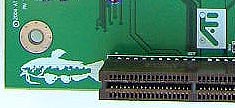
The Bullhead is an extremely wide-ranging variety of fish related to channel catfish. There is probably a lot more to the story.
| ATI RS480 Reference Board Specifications | |
| CPU Interface | Socket 939 Athlon 64 |
| Chipset | RS480/SB400 |
| Bus Speeds | 200MHz to 320MHz |
| PCI Express Speeds | PCIe FIX at 100MHz to 200MHz (in 1MHz increments) |
| Core Voltage | 1.0V to 1.7V in 0.025V increments |
| CPU Clock Multiplier | 4X-25.5X in 0.5X increments |
| CPU Auto Tuning | Off to 15% in 1% increments |
| HyperTransport Frequency | 1000MHz (1GHz) |
| HyperTransport Multiplier | 1X, 2X, 4X, 5X |
| DRAM Voltage | 2.6V, 2.85V |
| AGP Voltage | None available on Reference Board |
| HyperTransport Voltage | None available on Reference Board |
| Memory Slots | Four 184-pin DDR DIMM Slots Dual-Channel Configuration Regular Unbuffered Memory to 4GB Total |
| Expansion Slots | 1 x16 PCIe Slot 3 x1 PCIe Slots 2 PCI Slots 1 Dedicated Communications Riser |
| Onboard SATA/SATA RAID | 4 Drives by SB400 (RAID 0, 1) |
| Onboard IDE/IDE RAID | Two Standard ATA133/100/66 (4 drives) |
| Onboard USB 2.0/IEEE-1394 | 8 USB 2.0 ports supported by SB400 2 Firewire 1394A by VIA VT6306 |
| Onboard LAN | 1Gigabit Ethernet by Realtek 8110S-32 |
| Onboard Audio | AC '97 2.3 8-Channel by Realtek ALC655 |
| BIOS Revision | AMI AMBU-B10 11/02/2004 |
The ATI Bullhead Reference Board is truly unique among the Reference boards that we have tested. Normally, the Reference Board is devoid of BIOS adjustments and overclocking controls that may later appear on boards designed with the Reference chipset. The ATI Bullhead, on the other hand, is loaded with a huge range of controls that will make any enthusiast happy. It is very clear that ATI's goal was to demonstrate, on the front end, that their new chipset for AMD Athlon 64 can hold its own against any competition in the market. Given the enthusiast orientation of some other chipsets for Athlon 64, this was a very smart move by ATI. While ATI is well-known in the OEM market, this attention to flexible ranges and useful overclocking controls announces to the market that ATI intends to be a serious player in the Athlon 64 enthusiast arena.
As a result of the attention that ATI has lavished on the Bullhead, we have the capabilities of testing the overclocking capabilities and memory stress testing that are normally not possible with a Reference design.
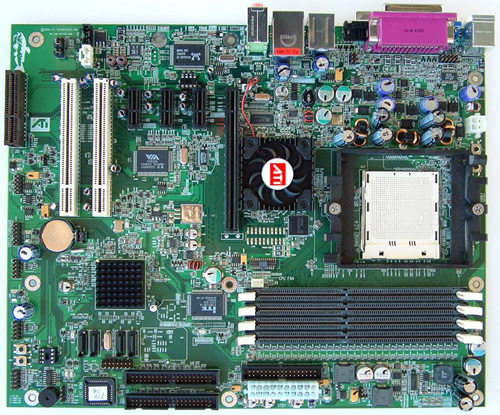
The ATI Bullhead is generally very well laid out - much better than we normally see in Reference boards. The power connectors are in the best position on board edges to ease power cable routing. The Hard Disks and SATA locations are reasonable. Even the floppy connector is in a better mid-board location instead of the bottom location that creates a challenge on many new boards. Manufacturers would do well to copy the ATI Bullhead Reference design. No board is perfect in layout, but the Bullhead is very easy to work with in most cases.

ATI also included a full range of IO ports on the Bullhead Reference board. Additional audio connectors are available on a port header in the dedicated CNR slot. The range of options and ports is unusually complete for a Reference board. Once again, the Reference design is worth copying by manufacturers. Perhaps ATI realized that without the chipset history of nVidia or VIA, they would have to work harder to get the market to take ATI seriously as a chipset option. One clever way to accomplish that is to deliver a Reference board that can be put into production by manufacturers without much, if any, redesign. It works for graphics cards, and it can certainly also work for motherboards.
BIOS Features: ATI Bullhead
It is rare that we would want to show the BIOS options for a chipset in more than basic features, but the options available to the reviewer are unusually complete on the ATI Bullhead.ATI chose the AMI BIOS, which is used by Asus and many other manufacturers on their AMD Athlon 64 motherboards.

Since the ATI RX480 is designed for qualification, you may not see the same range of tweaking options on shipping boards. However, it is worth showing some of the more interesting options from the BIOS, just so readers will know that they can be implemented on an ATI RX480/RS480 board.

Many tweaks can be found in the Advanced Menu. This includes many of the features of interest to overclockers.
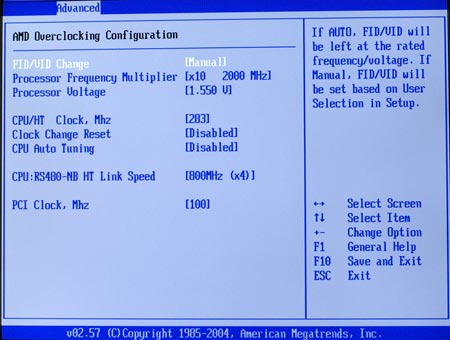
As you can see, the AMD Overclocking section has adjustments for Ratios, CPU voltage, clock speed, Hyper Transport Speed, Auto-Tuning, and PCIe clock.

Memory timings and voltage are found in the Chipset, Northbridge menu.
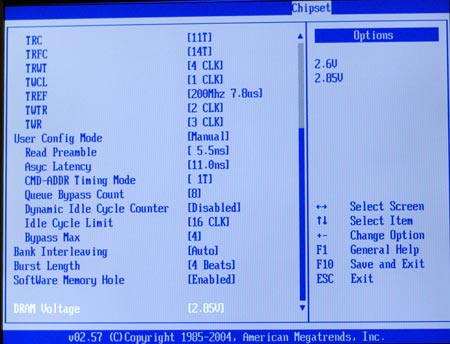
Memory tweaks even include a User Config mode with additional memory adjustments. The Memory controls are among the best that you will ever see in an Athlon 64 BIOS.

The Southbridge controls include a range of options for the integrated peripherals...
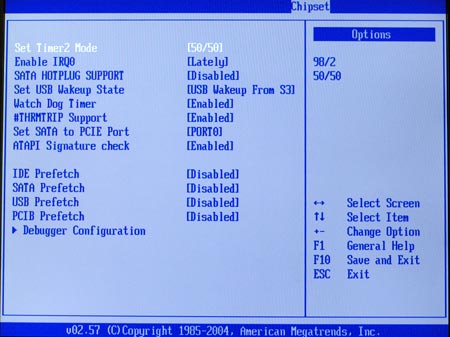
...and a Southbridge Debug Configuration menu.

For RS480 chipsets, you will also find an RS480 menu under chipsets. Options in the RS480 allow control of the integrated graphics and graphics related options like SurroundView.
The point, of course, is that ATI supplied the ATI Bullhead loaded with the kinds of options that reviewers need to get the most out of the RX480/RS480 chipset. With a full range of options and wide adjustment ranges, we couldn't wait to see where we could take the Bullhead in overclocking.
Overclocking: ATI Bullhead
ATI has some stiff competition from nVidia in the Athlon 64 Enthusiast market. nVidia is well known and trusted by AMD enthusiasts who know the nForce3 Ultra and nForce4 will provide the kind of extra performance they are looking for.Move over, nVidia, because the ATI Reference board reached an amazing 283x10 at 4X HyperTransport and 2.5-3-3-10 memory timings.
| Front Side Bus Overclocking Testbed | |
| Default Voltage | |
| Processor: | Athlon 64 FX55 2.6GHz |
| CPU Voltage: | 1.5V (default) |
| Cooling: | Thermaltake Silent Boost K8 Heatsink/Fan |
| Power Supply: | OCZ Power Stream 520W |
| Memory: | OCZ PC3200 EL Platinum Rev. 2 |
| Hard Drive: | Seagate 120MB PATA (IDE) 8MB Cache |
| Maximum OC: (Standard Ratio) |
224x13, 2912MHz (+12%), 1:1 DC Mode, 2-2-2-10 memory timings, 5X HT, 2.6V |
| Maximum FSB: (Lower Ratio) |
283 x 10 (2813MHz), 2 dimms, 1:1 DC mode, 2.5-3-3-10 1T memory timings, 4X HT, 2.85V |
Using Hynix Rev. B double-sided memory, we were also able to reach a 291 (DDR582) overclock, matching the highest overclock that we have ever achieved in testing with DS DIMMs in Dual-Channel mode. The timings and bandwidth were lower at 291, which also required 2X HT, since 3X was not an option in the ATI RX480 BIOS. ATI tells us that 3X will be implemented in production BIOS for the Bullhead board. 283x10 at 2.5-3-3-10 gave the highest memory bandwidth available on the ATI with our standard overclocking test setup.
Intrigued by the performance of double-sided DIMMs in dual-channel mode, we asked ATI about the highest performance dual-channel overclocking that they had achieved with the RX480 in their labs. ATI shared results and timings using 2 single-sided 256MB PQI DIMMs at 2.5-4-4-9 1T timings, at a frequency of 313 or DDR616. We did not have single-sided Hynix B DIMMs in the lab to try to duplicate ATI's test setup. However, based on our results with DS DIMMs, we have no reason to doubt their results. If you compare these overclocks to the outstanding overclocking capabilities that we found with the DFI LANParty UT nF3-250Gb, you will see that the ATI Bullhead is reaching further in Dual-Channel mode than the highest clock speed that we could reach in single-channel mode on the Socket 754 DFI.
In our opinion, ATI has more than succeeded in their goal of proving to computer enthusiasts that the RX480 is a chipset for serious performance overclocking. These are, overall, the best overclocking results that we have ever seen with an Athlon 64 motherboard. The fact that these were achieved on a Reference board is all the more amazing!
Front Side Bus Stress Test Results:
As part of our overclocking tests, a full range of stress tests and benchmarks were run to make certain that the ATI RX480 Bullhead was stable at each overclocked FSB speed. This included Prime95 torture tests and the addition of other tasks while Prime95 was running in the background. Many motherboards reach high overclocks and then behave as if they are on the ragged edge at those high overclocks. The ATI Bullhead was remarkably stable at both 224x13 (CPU Limited) and the even more challenging 283x10. For maximum stability at both settings, we needed a modest increase in CPU voltage to 1.55V, but at that setting, we were able to loop benchmarks for several hours without a system failure.Memory Stress Testing: ATI Bullhead
The memory stress test is very basic. It simply tests the ability of the ATI RX480 to operate at its officially supported memory frequency (400MHz DDR), at the lowest memory timings that OCZ PC3200 Platinum Rev. 2 modules will support. All DIMMs used for stress testing were 512MB double-sided (or double-bank) memory. Memory was only tested in Dual-Channel mode using either one dual-channel (2 DIMMs) or 2 dual-channels (4 DIMMs).| Stable DDR400 Timings - One Dual-Channel (2/4 DIMMs populated) |
|
| Clock Speed: | 200MHz |
| CAS Latency: | 2.0 |
| RAS to CAS Delay: | 2T |
| RAS Precharge: | 10T* |
| Precharge Delay: | 2T |
| Command Rate: | 1T |
Using two DIMMs in Dual-Channel 128-bit mode, the memory performed in all benchmarks at the fastest 2-2-2-10 timings at 2.6V.
| Stable DDR400 Timings - Two Dual-Channel (4/4 DIMMs populated) |
|
| Clock Speed: | 166MHz |
| CAS Latency: | 2.0 |
| RAS to CAS Delay: | 2T |
| RAS Precharge: | 10T* |
| Precharge Delay: | 2T |
| Command Rate: | 2T |
Tests with all four DIMM slots populated on the ATI Bullhead required a 2T Command Rate with 4 DIMMs in two dual channels. This is the pattern seen on other top-performing Socket 939 boards. This should not be a surprise, since the A64 memory controller is located on the CPU and not a part of the chipset itself. On the Auto setting, the ATI RX480 set the memory speed to 166, and a manual override to 200 did not work with 4 DIMMs. ATI specifies 4 DIMMs to be set to DDR166 at 2T Command Rate, but most of the better Socket 939 boards that we have tested run fine at DDR400 at 2T. ATI tells us that the override not working is an issue in current BIOS code, which they expect to be fixed with production boards.
UPDATE 11/11/2004: ATI has provided an updated BIOS which corrects the issues of 333 timings with 4 double-sided dimms. With the new BIOS we were able to run 4X512MB DS OCZ 3200 Platinum Rev.2 at 2-2-2-10 timings at DDR400 with a 2T Command Rate. This performance matches the best we have seen with 4 DS dimms on an Athlon 64 motherboard.
ATI RX480: Measuring Performance
The ATI Bullhead has shown itself to be an outstanding performer in overclocking performance, easily matching or surpassing the best Athlon 64 boards that we have tested. But the best overclocking that we have seen doesn't mean much unless the ATI RX480 also shows stock performance that is competitive with the best Athlon 64 boards.To determine how the ATI RX480 Bullhead compared to other Socket 939 boards, several different areas were compared.
- First, the ATI RX480 Bullhead was compared to performance of the Gold Editors Choice MSI K8N Neo2, which is based on the nVidia nForce3 Ultra chipset. We ran a brief series of game benchmarks on both boards to see if the ATI measured up in performance at stock speed. The ATI is PCI Express and the MSI is AGP, so the ATI Bullhead was equipped with an ATI X800 XT PCIe, and tests on the MSI K8N Neo2 were with an ATI X800 XT AGP video card. Both systems used the same 3800+ and the same 2-2-2-10 memory. Results are on page 9.
- Next, the performance of the PCI Express ATI RX480 was compared to the PCI Express nForce4 using the same ATI X800 PCI Express video card. A brief series of benchmarks on both boards were performed using the same FX55 CPU and memory. Results are on page 10.
- The performance of the ATI RX480 and nForce4 were then compared using the same nVidia 6800 Ultra PCI Express video card. The FX55 and memory were the same on both test boards. Results are on page 11.
- Full motherboard benchmarks were run with the ATI RX480 Bullhead using both the ATI X800 XT PCIe video card and the nVidia 6800 Ultra PCIe. These results are to establish baselines for both video cards on the ATI RX480 that can be compared to past benchmarks and to future motherboard testing. The purpose was not to compare video cards, although we suspect that the results will be used by some for comparing nVidia and ATI PCIe performance. Results begin on page 12.
Performance Test Configuration
If you are interested in more information comparing the Athlon 64 chipsets, the Athlon 64, and the Athlon 64 FX, please see our in-depth comparisons in the recent launch reviews:AMD Athlon 64 4000+ & FX-55: A Thorough Investigation
nForce4: PCI Express and SLI for Athlon 64
.09 Athlon 64: Value, Speed and Overclocking
AMD Sempron: A Fresh Take on Budget Computing
Socket 939 Chipsets: Motherboard Performance & PCI/AGP Locks
AMD Athlon 64 3800+ and FX-53: The First 939 CPUs
| Performance Test Configuration | |
| Processor(s): | AMD Athlon 64 FX55 (2.6GHz) Socket 939 |
| RAM: | 2 x 512MB OCZ PC3200 Platinum Rev. 2 |
| Hard Drive(s): | Seagate 120GB 7200 RPM IDE (8MB Buffer) |
| Chipset Drivers: | nVidia nForce 6.11 Beta (nForce4) nVidia nForce Platform Driver 4.24 (nForce3 Ultra) |
| Video Card(s): | ATI X800 XT (PCI Express) ATI X800 XT (AGP 8X) nVidia 6800 Ultra (PCI Express) nVidia 6800 Ultra (AGP 8X) |
| Video Drivers: | ATI Catalyst 4.10 (All ATI Video tests) nVidia nForce 61.81 Beta (nForce4) nVidia nForce 61.77 (nForce3 Ultra) |
| Operation System(s): | Windows XP Professional SP1 |
| Motherboards: | ATI Bullhead (RX480/RS480 PCIe) nVidia nForce4 Ultra Reference Board MSI K8N Neo2 (nVidia nForce3-250Gb) |
Tests used OCZ PC3200 Platinum Rev. 2, G. Skill TCCD, or Corsair 3200XL XMS3208v1.1 memory modules. All three memories use Samsung TCCD chips and perform virtually the same in our benchmarks at stock speed. Resolution in all benchmarks is 1024x768x32, unless noted otherwise.
ATI X800 XT: MSI K8N Neo2 vs. ATI Bullhead
The MSI K8N Neo2 was our Gold Editors Choice in our Socket 939 Roundup. We first compared the ATI RX480 Bullhead to the MSI running the same Athlon 64 3800+ CPU and the same 2-2-2-10 DDR memory. An ATI XT X800 AGP video card was used for the nForce3 Ultra testing while an X800XT PCIe was used for the ATI Bullhead.| MSI K8N Neo2 vs. ATI Bullhead ATI X800 XT (AGP and PCIe), 3800+, 2X512 2-2-2-10 DDR |
|||
| Benchmark | MSI K8N Neo2 nVidia nForce 3 |
ATI Bullhead ATI RX480 |
% Change MSI to ATI |
| PCMark 2004 | 4880 | 4812 | -1.4% |
| Aquamark 3 | 65620 | 65070 | -0.8% |
| Doom3 - High Quality | 85.9 | 87.3 | +1.6% |
| Far Cry 1.1 | 151.4 | 159.0 | +5.0% |
In many graphics roundups we have seen no real performance difference in AGP and PCI Express versions of the same card. Therfore, we are comparing the ATI RX480 performance to nForce3 Ultra. The % variation is negligible except for Far Cry, where the ATI Bullhead is about 5% faster. As reported at AnandTech in past video reviews, nVidia PCIe is not as well-optimized for Far Cry as ATI. However, it looks like the problem is not just the nVidia PCIe, since the ATI card also is slower on the nVidia chipset than on ATI RX480.
Since the Far Cry issue is known, and will be clearer in other benchmarks reported here, we conclude that the ATI Bullhead and MSI K8N Neo2 are equivalent in performance.
ATI X800 XT PCIe: nVidia nForce4 vs. ATI Bullhead
nVidia introduced nForce4 several weeks ago as their PCI Express updated version of the nForce chipset for Athlon 64. In nForce4: PCI Express and SLI for Athlon 64, we concluded the performance of nForce 4 and nForce3 Ultra was basically the same. However, with nForce4 sporting PCI Express graphics, we have the opportunity to compare the same PCIe video card directly on both systems. We first compared performance of the ATI X800 XT PCIe on both the ATI Bullhead Reference board and the nVidia nForce4 Reference board.| ATI X800 XT (PCIe), nVidia nForce4 vs. ATI Bullhead FX55, 2X512MB, 2-2-2-10 DDR |
|||
| Benchmark | nVidia nForce4 | ATI Bullhead ATI RX480 |
% Change nF4 to ATI |
| Halo | 106.6 | 121.9 | +14.4% |
| UT2004 - High Quality | 74.0 | 74.4 | +0.5% |
| Doom3 - High Quality | 102.5 | 97.9 | -4.5% |
| Far Cry 1.1 | 158.9 | 168.6 | +6.1% |
| RTCW - Enemy Territory Radar | 114.0 | 115.3 | +1.1% |
There are some very interesting results comparing ATI PCIe video on both systems. First, we see that Far Cry is still slower on nVidia, even with the ATI PCIe video card. This leads us to conclude that at least part of the performance hit that we see with Far Cry is a result of nVidia chipset or driver code. We see a similar anomaly in Doom 3 being slower with the ATI card on the ATI than it is with ATI on nVidia. Since everything else is the same in both setups, we again would look to ATI drivers or chipset code as the likely issue.
Halo is a significant 14.4% slower on nVidia/ATI than on ATI/ATI, but you will see in later benchmarks that nVidia PCIe on nVidia is roughly equivalent in performance to ATI PCIe on ATI. In the larger picture, this is a driver/code issue worth a look by manufacturers, but it doesn't reflect any real performance differences in these chipsets. Overall, the ATI Bullhead can be considered equivalent to a bit faster in performance than nForce 4 with both running an ATI PCIe video card. This is a remarkable accomplishment for the new ATI RX480/RS480 chipset compared to the more mature nVidia nForce4.
nVidia 6800 Ultra PCIe: nVidia nForce4 vs. ATI Bullhead
With both ATI Bullhead and nVidia nForce4 sporting PCI Express, we also looked at the performance of the nVidia 6800 Ultra PCIe on both boards.| nVidia 6800 Ultra (PCIe), nVidia nForce4 vs. ATI Bullhead FX55, 2X512MB, 2-2-2-10 DDR |
|||
| Benchmark | nVidia nForce4 | ATI Bullhead ATI RX480 |
% Change nF4 to ATI |
| Halo | 122.7 | 119.0 | -3.0% |
| UT2004 - High Quality | 75.1 | 75.2 | +0.1% |
| Doom3 - High Quality | 106.0 | 103.9 | -2% |
| Far Cry 1.1 | 136.6 | 144.2 | +5.6% |
| RTCW - Enemy Territory Radar | 121.1 | 119.0 | -1.7% |
| PCMark 2004 | 5234 | 5214 | -0.4% |
| Aquamark 3 | 73177 | 71008 | -3.0% |
As you can see, the Halo score for nVidia on nVidia is about the same as our past tests of ATI on ATI. nVidia on ATI is about 3% slower than the nVidia on nF4. Far Cry continues the pattern of best performance on an ATI chipset and/or an ATI graphics card. Doom 3 and Aquamark 3 are also very slightly slower on nVidia/ATI than nVidia/nVidia, but the % change of 2% to 3% is hardly significant.
The ATI Bullhead is equivalent to slightly slower with an nVidia PCIe card than an nVidia nForce4 chipset running the same nVidia card. nVidia has claimed that nVidia on nVidia is a faster combination than ATI on nVidia, but we can only conclude that these performance differences are not very significant. ATI/ATI and nVidia/nVidia are the fastest combinations in our comparisons, but the differences are so tiny that they really don't matter. You can run any of these in combination with each other without any concern that you have to match Athlon 64 chipset to Graphics chipset.
The most revealing fact in these comparisons is that no matter how you look at the new ATI RX480 chipset, it is completely competitive with the best Athlon 64 chipsets that we have tested.
ATI Bullhead: General Performance and Encoding
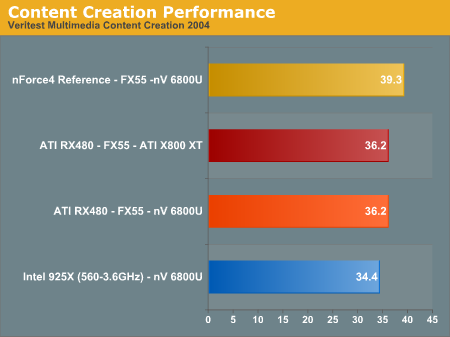
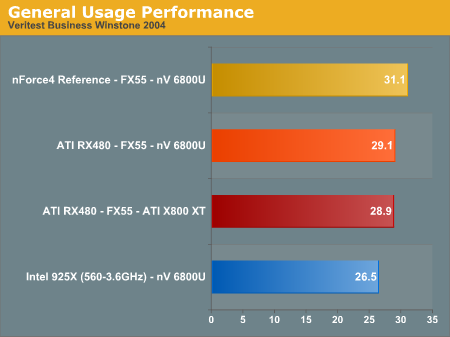
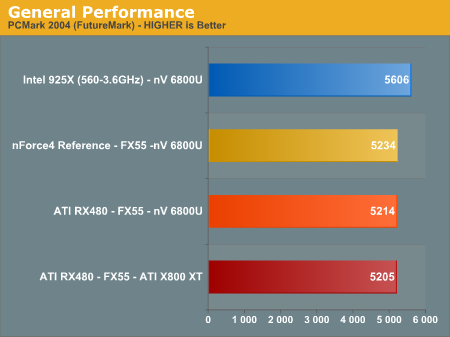
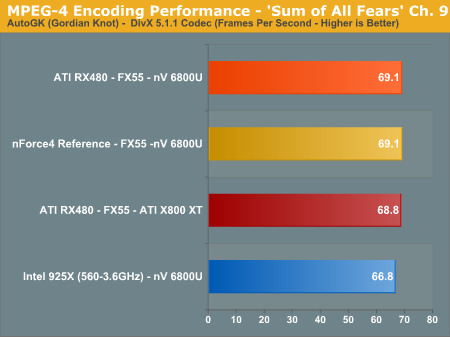
nVidia performs much better in the Winstone benchmarks - a pattern we have seen for some time. Compared to VIA and now ATI, nVidia enjoys about a 6% to 8% advantage in Multimedia Content Creation and Business Winstone. This is likely the result of nVidia's heavily optimized IDE drivers for their chipsets, as we started seeing this pattern beginning with nForce2. To be completely competetive with nVidia, ATI needs to do further work on their chipset driver performance.
PCMark 2004 and Media Encoding with AutoGK results are the same with both chipsets.
ATI Bullhead: DX9 Gaming Performance

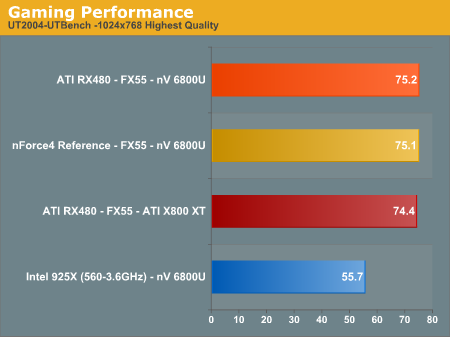
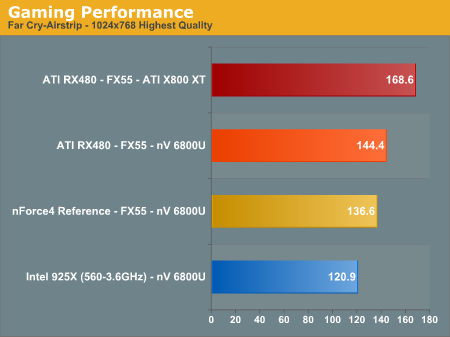

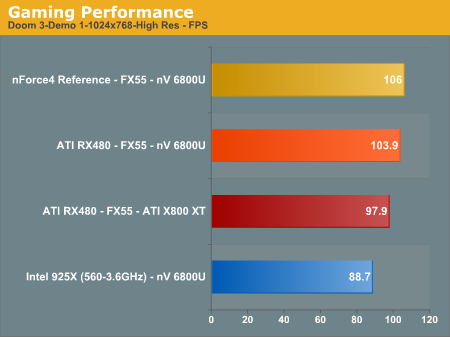
ATI Bullhead: DX8 and OpenGL Gaming Performance
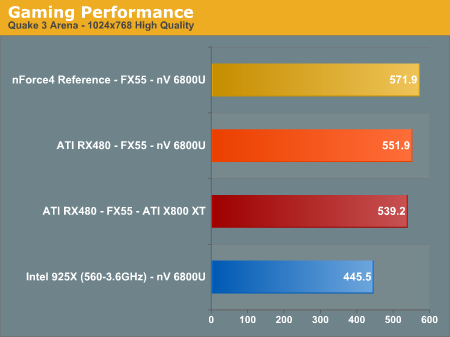
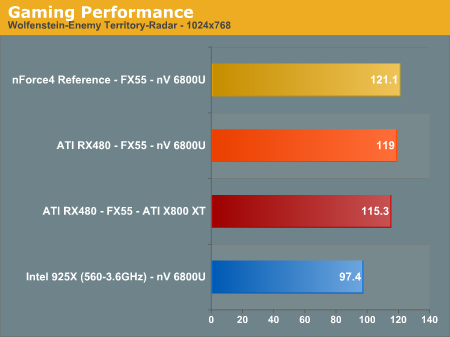
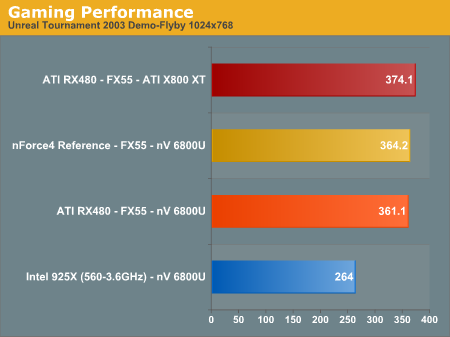
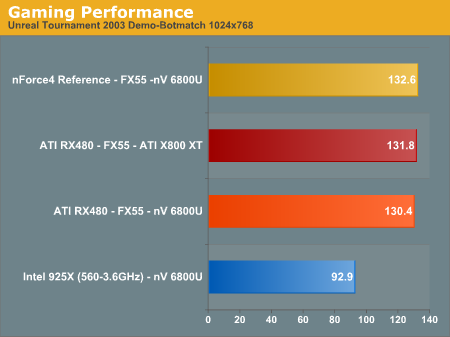
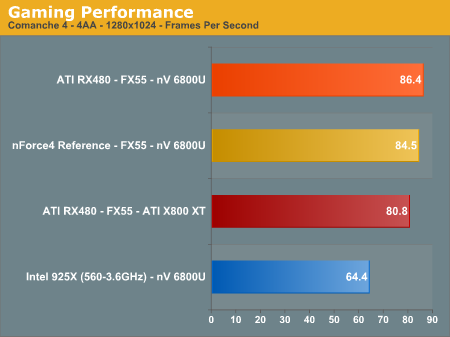
ATI Bullhead: Workstation Performance
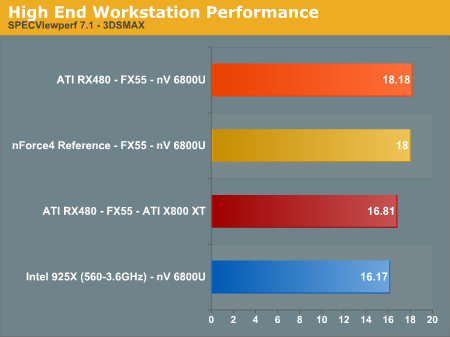
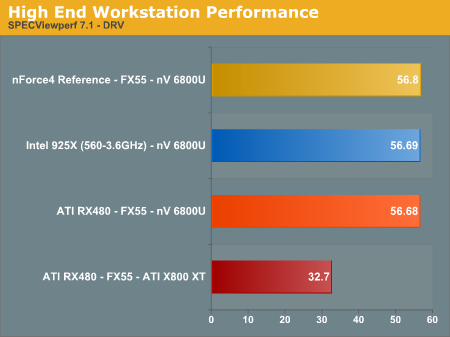
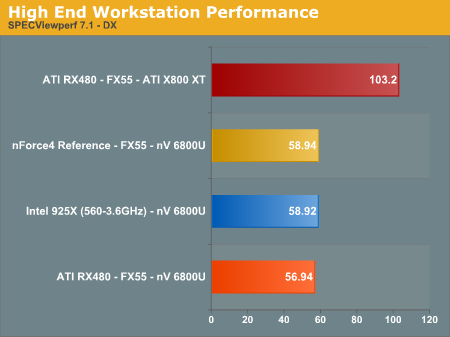
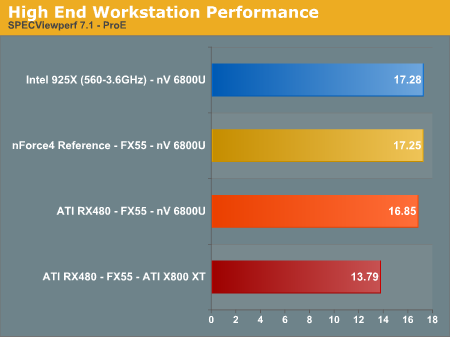
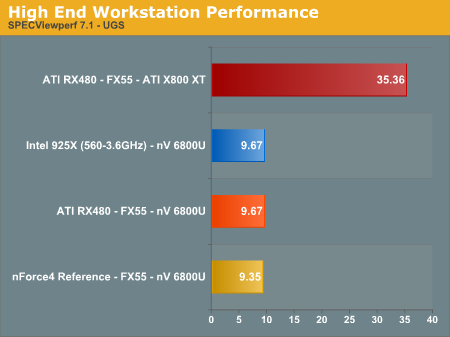
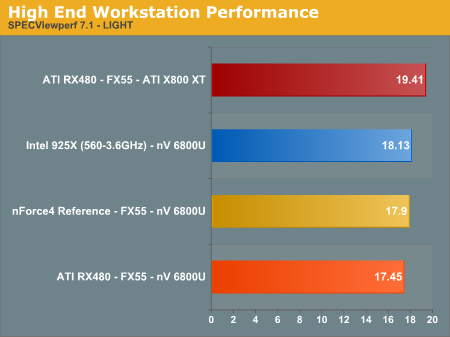
ATI Graphics and nVidia Graphics behave quite differently in SPECviewperf 7.1 benchmarks. If you will check past reviews you will see the patterns here are typical for each chipset and nothing unusual. What this means in real terms is it is not very useful to compare ATI and nVidia graphics performance in SPECviewperf, but it is useful to compare ATI to ATI or nVidia to nVidia with different boards. The ATI X800 XT PCIe Workstation results are here to establish baselines for the Rx480 chipset with ATI video. The only useful comparisons are the 3 systems with nVidia 6800 Ultra PCIe.
Radeon Xpress' Integrated DirectX 9 GPU
Although we generally focus on the performance of desktop chipsets with the fastest discrete graphics solutions, in order to truly be successful in the chipset business, you have to gain significant OEM market share. And what do the majority of computers sold use? Chipsets with integrated graphics.The integrated graphics core on a North Bridge comprises almost 90% of the die, but despite this figure, in terms of GPU performance, integrated graphics solutions generally perform far worse than even the cheapest discrete graphics solutions. Part of the reason behind this phenomenon is that the major chipset manufacturers (Intel, SiS, VIA) are not graphics companies, and they operate on fairly long 2-year product cycles for major changes in their graphics designs.
When NVIDIA first made an effort to get into the chipset business, they brought their graphics expertise to the market - quickly raising the performance bar with integrated graphics solutions. But with the nForce4, NVIDIA lacks an integrated graphics solution for the Athlon 64 platform, paving the way for ATI's Radeon Xpress 200 to make a splash.
In the past, you could integrate the slowest desktop GPU into a chipset unmodified, but with the extreme complexity and FP requirements of DirectX 9 GPUs, this is no longer possible. The Radeon Xpress 200 features a modified version of the X300 core, modified to have only two operational pixel pipelines. As a desktop part, only having two pipes would be terrible for performance, but keeping in mind that the market for integrated graphics solution is much less performance-conscious, then it's much more acceptable.
With only two pixel pipes, the Radeon Xpress integrated graphics core can render up to two pixels per clock, with the ability of applying one texture operation per pixel per clock. Compared to Intel's Graphics Media Accelerator 900 (the integrated graphics core of the 915G chipset), ATI is actually at a disadvantage here, with the GMA 900 capable of rendering 4 pixels per clock. Where the Radeon Xpress integrated graphics pulls ahead in the specs is in its two hardware vertex engines. Intel's GMA 900 features no hardware vertex acceleration and instead, depends on the host CPU to handle all vertex operations.
The Radeon Xpress 200 is built on a 0.13-micron process, a larger process than what the 110nm process the X300 is built on, and thus, the integrated GPU runs at a slower core clock speed of 300MHz.
Since the Radeon Xpress' integrated graphics core is based on the X300's core, game compatibility - a weakness for Intel's GMA 900 - should not be an issue with the integrated graphics. If you look back at our recent review of NVIDIA's GeForce 6200, out of the 8 games that we tested, only 5 would run on Intel's integrated graphics solution. Given that integrated graphics is usually all that first-time gamers have access to, game compatibility is quite important.
SidePort: On-Board GPU Memory
Just before the launch of the Athlon 64, we found that many chipset manufacturers were a bit worried about the performance of integrated graphics solutions and AMD's new CPU. The worries stemmed from the fact that in previous CPU/chipset architectures, the integrated graphics cores resided on the North Bridge and shared access to the system memory controller - also located on the North Bridge. With the Athlon 64, however, the memory controller resides in the CPU, increasing memory access latencies from the perspective of the integrated graphics core.The Radeon Xpress 200 supports a local frame buffer attached to what ATI refers to as their "SidePort". The SidePort is a 32-bit DDR memory interface that the integrated graphics can use either instead of or alongside the Athlon 64's memory controller.
While we assumed that SidePort was included to hide some of the latencies of using the Athlon 64's memory controller, that ended up not being true as performance in UMA mode (using the Athlon 64's memory controller) was quite respectable. It turns out that most games don't benefit too much from lower latency memory accesses (through SidePort). So, why would ATI include support for a local frame buffer with the Radeon Xpress 200? Although performance is improved with SidePort enabled, the biggest reason for supporting the feature is to reduce power consumption in mobile environments. Without SidePort enabled, the CPU needs to be awake to fetch data for refreshing the display, but with SidePort enabled, all memory accesses can occur via the Radeon Xpress 200 and the CPU can remain asleep in power saving modes.
Because of the added cost of supporting SidePort, it isn't a requirement - the Radeon Xpress 200 has four memory operating modes:
- SidePort only - In this mode, the integrated graphics core treats the SidePort memory as its local memory. If more memory is needed, it is allocated dynamically through system memory by the driver, which is significantly higher latency than the local SidePort memory.
- UMA only - In UMA mode, the only memory to which the integrated graphics has access is a dynamically allocated partition of system memory. The size of the parition is selectable from within the BIOS (ATI's reference board allows for 16 - 128MB sizes). If more memory is needed, it is allocated dynamically through system memory by the driver.
- UMA + SidePort (Interleaving Disabled) - In this mode, the total amount of "local" graphics memory is the size of the UMA partition and the amount of memory connected to the Radeon Xpress' SidePort. The integrated graphics core will first use SidePort memory until it runs out, then using system memory. If more memory is needed, it is allocated dynamically through system memory by the driver.
- UMA + SidePort (Interleaving Enabled) - By enabling Interleaving and setting the UMA frame buffer size to the same size as the memory connected to the Radeon Xpress' SidePort, a special Interleaving mode is enabled. In this mode, the integrated graphics cores will request data from both the UMA space and SidePort memory. The benefit of Interleaving is that now two reads or writes can occur at the same time, whereas with just SidePort only a single 32-bit read/write can happen at any given time. Despite the fact that UMA accesses will be higher latency, the dual ported nature of this setup improves overall performance. There are situations when a SidePort only configuration will offer greater performance if the application depends on lower latency memory accesses. If more memory is needed it is dynamically allocated through system memory by the driver.
ATI's reference board features 16MB of DDR memory attached to the Radeon Xpress' SidePort. The memory can either run synchronously with the system memory clock (200MHz for DDR400) or asynchronously, where the speed is bound by the type of memory used. In our case, the 2.5ns Samsung DDR located on the board was capable of running at the maximum frequency the BIOS allowed - 350MHz.
As we mentioned before, the SidePort memory interface is a single 32-bit channel, which at 350MHz provides 1.4GB/s of bandwidth to the integrated graphics core. At 200MHz SidePort can only provide 800MB/s of bandwidth, so the additional latency incurred by running the SidePort asynchronously with main memory is well worth the additional bandwidth.
What's truly interesting is the pretty impressive performance of running in SidePort-only mode. Granted you are limited to low resolutions, but as you will soon see, the integrated graphics core isn't really designed to run at very high resolutions. In fact, running in SidePort-only mode is faster than running in UMA only mode with a single-channel Socket-754 Athlon 64.
The charts below do a good job of showing off the performance advantages to the various operating modes of the Radeon Xpress 200.
The first thing we see is that there's a huge performance advantage to the dual channel memory controller of the Socket-939 Athlon 64, - 33% in Doom 3 and 27% in UT2004. This is far from unexpected given that the more system memory bandwidth you have, the more graphics memory bandwidth you have.
The performance advantage to using the SidePort + UMA configuration isn't insignificant either - 8.5% in Doom 3 and 7.7% in UT2004, however with the added cost we would say that the SidePort isn't absolutely necessary for desktops (but we understand its usefulness in notebooks).

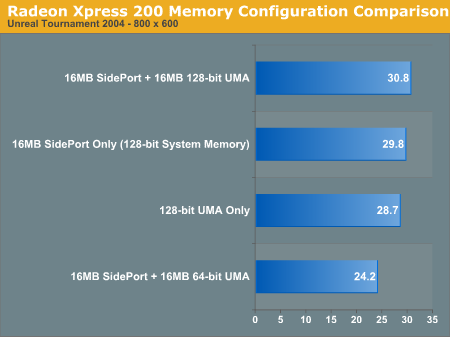
We compared the graphics performance of the Radeon Xpress 200 to ATI's lowest end discrete PCI Express graphics card: the Radeon X300 SE. The X300 SE is a four-pipe version of the Radeon Xpress 200 but with only a 64-bit DDR memory interface, so the Radeon Xpress 200 actually holds a memory bandwidth advantage over the X300 SE while it is at a fill rate deficit.
We also compared the Radeon Xpress 200 to Intel's Graphics Media Accelerator 900. While the GMA 900 is obviously only available on the Intel-only 915G and the Radeon Xpress 200 is an AMD-only solution, the two offerings are slow enough that most games end up being completely GPU limited and thus the CPU differences become negligible.
You'll notice that not all of the benchmarks have scores for Intel's GMA 900; those that don't have GMA 900 scores are ones where the GMA 900 was not able to either run the game or complete the benchmark without crashing.
Integrated Graphics Performance Comparison
Doom 3 Performance
The Radeon Xpress 200 does hold an advantage over Intel's GMA 900 in that it actually runs Doom 3, but that's really where the advantages end. The game is not very playable with the integrated graphics core, even at 640 x 480.The lowly Radeon X300 SE is basically twice as fast as the Radeon Xpress 200, which isn't saying much as the X300 SE is basically the minimum level of playability for Doom 3.
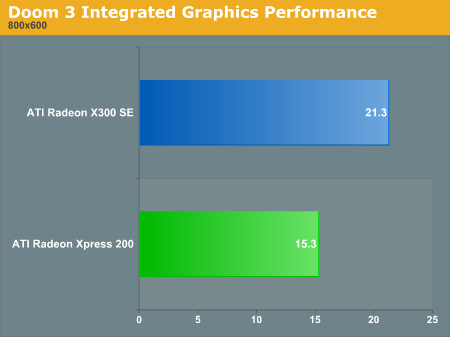
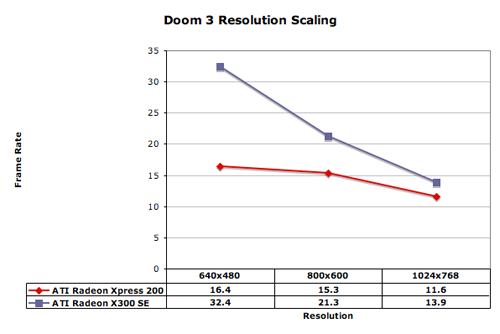
We did encounter a strange issue with the Radeon Xpress 200 in our testing, there are significant image quality issues with it under Doom 3. It doesn't make sense since, architecturally, there shouldn't be any difference between it and the X300 SE we compared it to (other than fewer rendering pipelines but that shouldn't cause the issue).
First, here's what Doom 3 should look like as rendered on our test Radeon X300 SE:
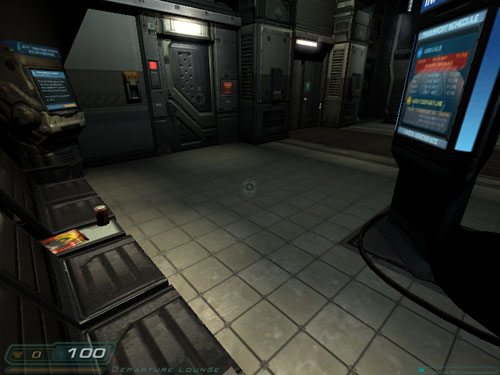
But here's what we get with the Radeon Xpress 200:

We have informed ATI of the issue and they are looking into it for us, but as far as we are concerned even with the image quality issues fixed, Doom 3 isn't really the type of game to be playing on integrated graphics, not even with the Radeon Xpress 200.
Half Life 2 Performance (VST)
Using the Source Visual Stress Test we look at a preview of Half Life 2 performance on these integrated graphics solutions.The Radeon Xpress 200 manages to perform reasonably well, definitely not as well as the X300 SE, but nothing that isn't playable. We will have to wait another week to see if it actually means that the integrated graphics will be playable in Half Life 2, but if the VST is any indication things are looking good.
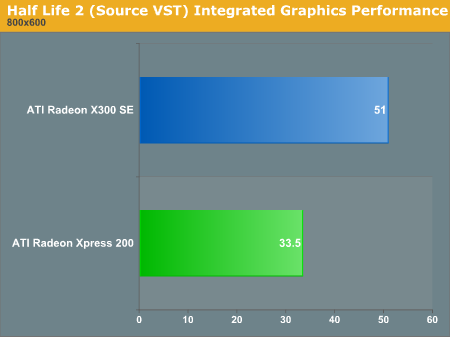
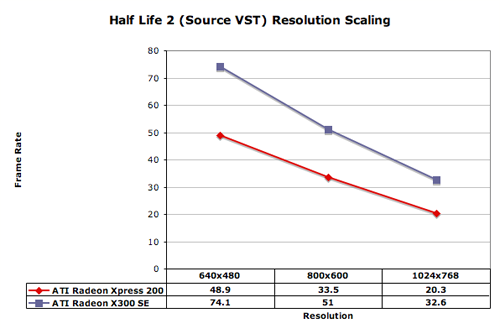
Unreal Tournament 2004 Performance
At 800 x 600 the Radeon Xpress 200 is playable, despite the fact that the X300 SE is 23% faster. Despite the fact that the Radeon Xpress 200 has much more memory bandwidth than the X300 SE thanks to the dual-channel DDR400 interface of the Socket-939 Athlon 64, its performance is significantly impaired by the reduction in rendering pipelines. But with the complexity of implementing fully floating point DX9 compliant rendering pipelines, it's tough to do more than 2 pipes at this stage without increasing cost significantly.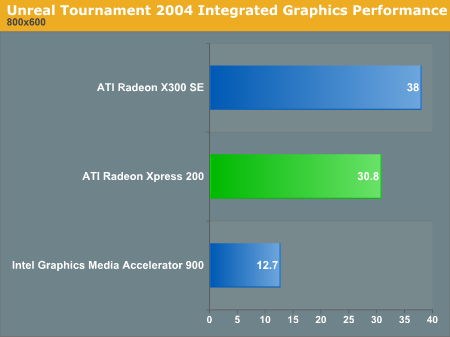
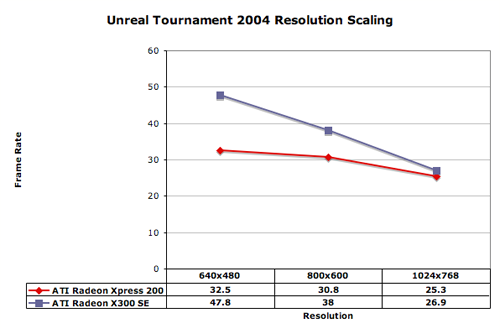
Halo Performance
Also playable, even at 800 x 600 (in actual gameplay), the Radeon Xpress 200 continues to do "ok" in the performance tests. It's better than Intel's GMA 900 in that it is able to offer this level of performance at much better image quality, but the performance isn't anything to get incredibly excited about as the $80 X300 SE wipes the floor with the Radeon Xpress 200. Granted we are comparing $0 to $80, so a performance difference is expected.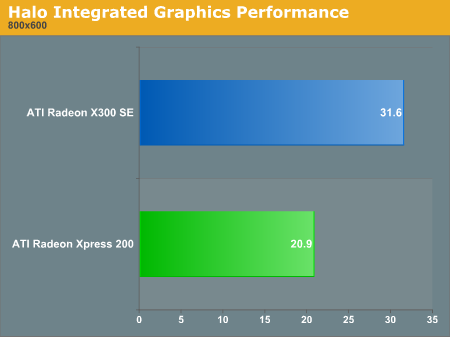

Wolfenstein: Enemy Territory Performance
Based on the Quake 3 engine, performance here is important because the types of games that will be mostly playable on integrated graphics solutions will be older titles.The Radeon Xpress 200 doesn't disappoint, performing within 10% of the X300 SE.
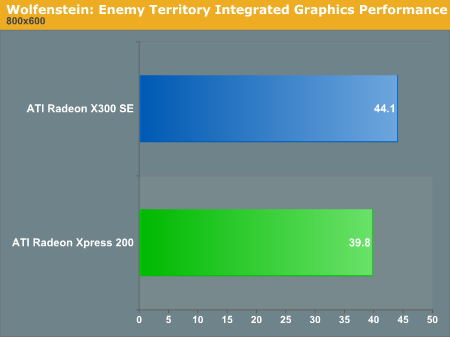

Integrated Graphics Performance Comparison (continued)
Far Cry 1.2 Performance
Offering twice the performance of the GMA 900, the Radeon Xpress 200 actually makes Far Cry playable. If you turn the quality settings down even further the game becomes even more playable, but at the expense of making it look like one big aliased blur.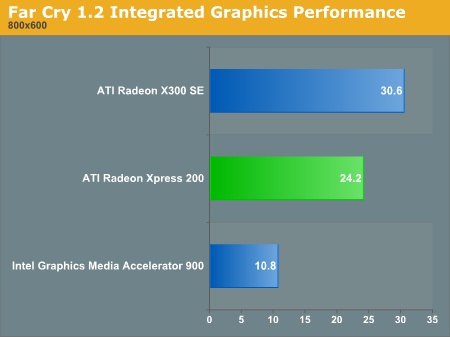
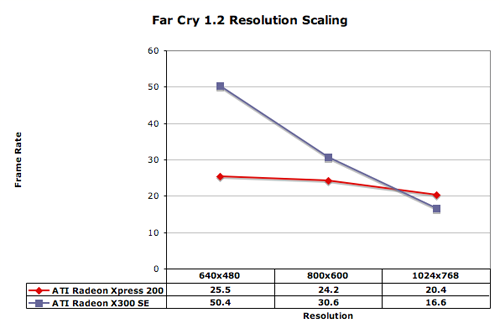
The Sims 2 Performance
In our GeForce 6200 review we found that Intel's GMA 900 actually performed pretty well under The Sims 2, which is the type of title where good performance really matters for an integrated graphics solution.To our surprise, ATI's Radeon Xpress 200 wasn't able to outperform the GMA 900 at all. The Radeon Xpress 200 can run at slightly better image quality settings than the best the GMA 900 can do, but overall the advantage isn't too impressive.
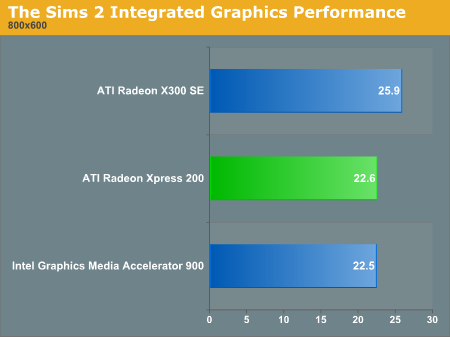
Battlefield Vietnam Performance
The Radeon Xpress 200 is quite playable under Battlefield Vietnam, especially at lower resolutions. The GMA 900 numbers are good for comparison, but keep in mind that the Radeon Xpress 200 is running here at better image quality settings.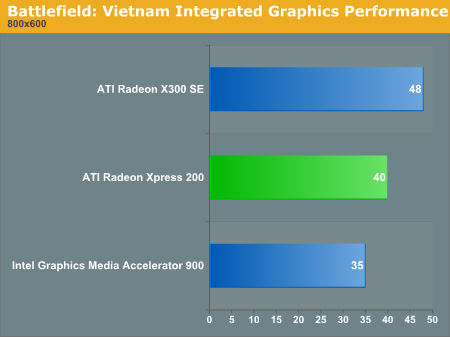
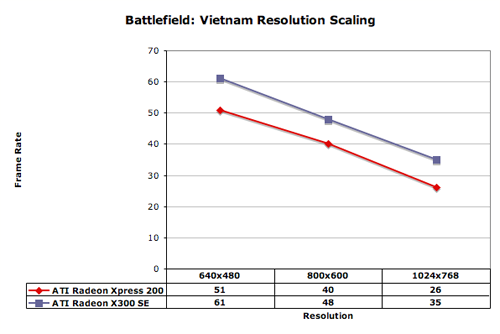
Warcraft III Performance
Surprisingly enough, in Warcraft III we actually saw higher performance from the Radeon Xpress 200 than the bandwidth limited Radeon X300 SE.
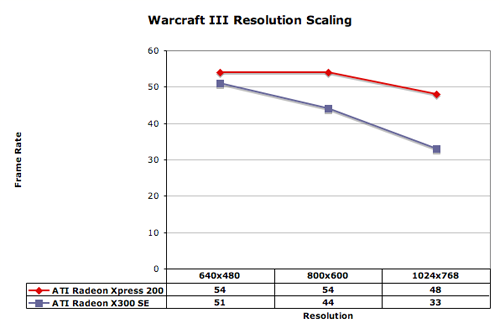
Integrated Graphics Performance: Conclusion
When the nForce2 was released, its integrated graphics could outperform the slowest GeForce4 MX 420, but not much more than that. With the move to full floating point DX9 architecture, die space, heat and transistor count are much more valid concerns, and it would seem that the days of just integrating a company's entry level GPU are over.The Radeon Xpress 200 does one very important thing better than Intel's integrated graphics - compatibility. Since the underlying architecture is based off of the X300, game compatibility isn't much of an issue.
The performance of the Radeon Xpress 200 is better than the integrated graphics of Intel's 915G, but it's not the type of demolishing performance we would expect from a chipset produced by one of the top two GPU manufacturers. Then again, performance isn't what sells in this market, after all, despite how bad Intel's integrated graphics performs it still sells incredibly well. We would have liked to see better performance out of the Radeon Xpress 200, at least X300 SE levels but with only two rendering pipelines it's tough to do. We understand the tradeoff ATI had to make, we just wish it didn't have to be this way. We'd take the Radeon Xpress 200 over Intel's integrated solution any day, but we can always want more. Rumor has it that ATI's Intel chipset will feature an updated graphics core, so we may just get our wish sooner than expected.
SurroundView however does make up for things, enabling excellent multimonitor support for between 2 and 4 displays - something no other platform can currently promise. In our opinion, if you've got the monitors, SurroundView itself is worth the price premium of the Radeon Xpress 200 over the discrete-only 200P. For us, more desktop space is always a plus and with three monitors it's something that's quite attainable.
SurroundView: Enabling More than Two Displays
Back when NVIDIA released the nForce chipset, we wondered if it would be possible to use the integrated graphics in conjunction with an add-in graphics card to enable multimonitor support. Unfortunately back then it was not possible, but now with the Radeon Xpress 200, ATI has granted our wish.When used with an add-in graphics card, the Radeon Xpress's integrated graphics can be used to drive a second, third or even fourth display. The integrated graphics core of the Radeon Xpress 200 features two display outputs, and ATI's reference board itself had both a VGA and a DVI output on the board to take advantage of these two display outputs. With a PCI Express graphics card, you can use the display outputs on the graphics card in conjunction with those on the motherboard to drive up to four monitors. Right now ATI has only validated the Radeon Xpress 200 for operation in triple display mode but nothing should stop them from enabling four display outputs.
To enable triple display output you first must select the option in the BIOS to enable SurroundView. Your PCI Express graphics card will, by default, function as your primary display driver, but of course this is reconfigurable once in Windows.
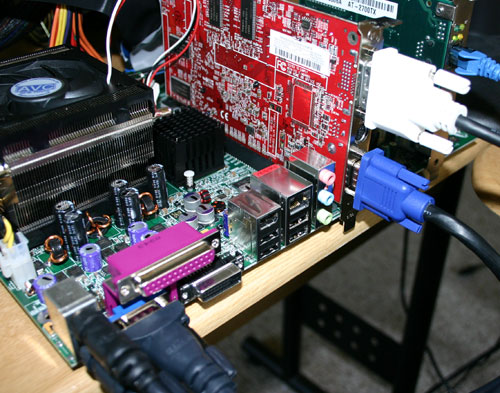
When in Windows, simply select to extend your desktop across the multiple monitors much like you would in a 2-monitor scenario and you're done. We applaud ATI for the inclusion of this feature in the Radeon Xpress 200 chipset as it is truly a reason for even a high end user to purchase their integrated chipset. The VGA output on the reference board had no problems with sharpness or image quality at high resolutions, but we'll reserve final judgment for the retail boards that end up shipping.
Final Words
Round 3 has been the most interesting round of the Athlon 64 chipset wars. VIA was first to demonstrate their PCI Express chipset, but it now appears they may be the last with retail product to the market. nVidia showed their nForce 4 PCIe Reference board just a few weeks ago and we are already expecting production samples from Tier 1 motherboard makers in the next week. ATI was last to announce a PCI Express chipset for Athlon 64, but OEM boards are already starting to ship from makers like MSI. That is not to say that Enthusiast boards based on the RX480 and high-end designs with the RS480 are shipping, as it will still be several weeks until these boards make their way to market.For their first effort at an AMD Athlon 64 chipset, we can only say we are beyond impressed with the ATI RX480/RS480 chipset. No matter how we compare the performance the ATI RX480 is competitive or a bit faster than the best Socket 939 boards we have tested at AnandTech. That in itself would be reason enough to suggest a long, hard look at the ATI RX480 chipset, but there's more. ATI also did their homework in this go round; delivering a board that will excite any enthusiast who gives it a whirl. nVidia got to their position of prominence in the AMD world with solid boards that catered to Enthusiasts. ATI appears to finally understand that pleasing the OEM market is not the same as exciting Enthusiasts. The ATI Bullhead is a monster overclocker with amazing performance, and ATI deserves huge praise for their efforts and their results with their first AMD chipset.
To competitive Athlon 64 performance and demonstrated overclocking abilities, we then add ATI's first DirectX 9 graphics. While the performance of the integrated graphics core can't even beat a X300 SE, ATI does stand alone in offering DX9 graphics compatibility on an integrated Athlon 64 platform. Compared to Intel's GMA 900, ATI's integrated graphics is a step (or two) ahead; add to that the exciting potential of Surround View with 3 or 4 monitors and the ATI RS480 chipset certainly looks like a worthwhile choice.
If we were to compare the very capable Athlon 64 solutions, our choice right now would be the new ATI RX480/RX480, but nVidia threw a significant wrench into the A64 with their simultaneous launch of SLI with nForce 4. Our previews have demonstrated that SLI is a significant boost for graphics performance. Combining two video cards is a solution that will definitely appeal to those aiming for top performance at one end of the spectrum and those seeking graphics upgradeability at the other end. For the rest of the market the ATI Radeon Express 200P and 200 will be a great choice. It is also worth noting that ATI specified that the x16 PCIe graphics slot can be programmed "to drive two devices". ATI shared plans to market their own SLI solution that they expect to launch in early 2005, so SLI will also likely be a choice with ATI in the near future.
We have no hesitation in recommending ATI Radeon Express as either a discrete or integrated solution for a top-line Athlon 64 system. The ATI will not disappoint in either stock performance, features, or overclocking capabilities that top the Athlon 64 pack. Our only concern at this point is that motherboard manufacturers in Taiwan are not accustomed to thinking of ATI for AMD chipsets. This means they may not even consider how really good ATI RX480/RS480 actually are. To them we say please take a closer look. The ATI RX480/RS480 are outstanding performers that definitely deserve a place on some top Enthusiast Athlon 64 motherboards.
Congratulations, ATI, you managed to pull it off! The last announcement of Round 3 of the Athlon 64 chipset wars may turn out to be the most significant introduction of all.

